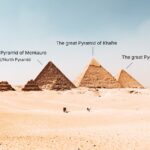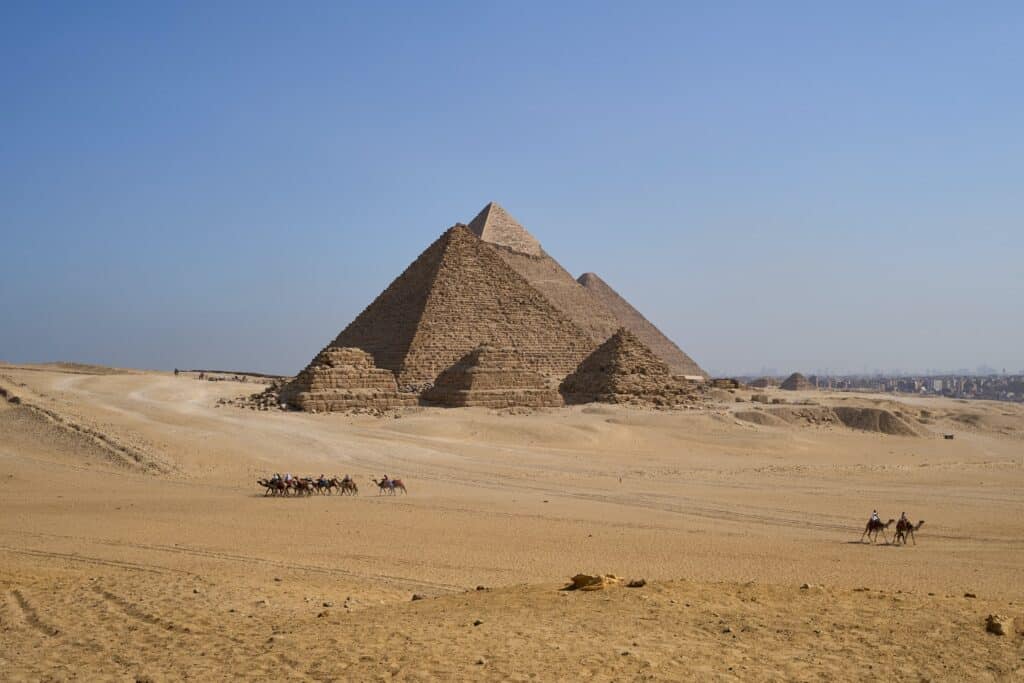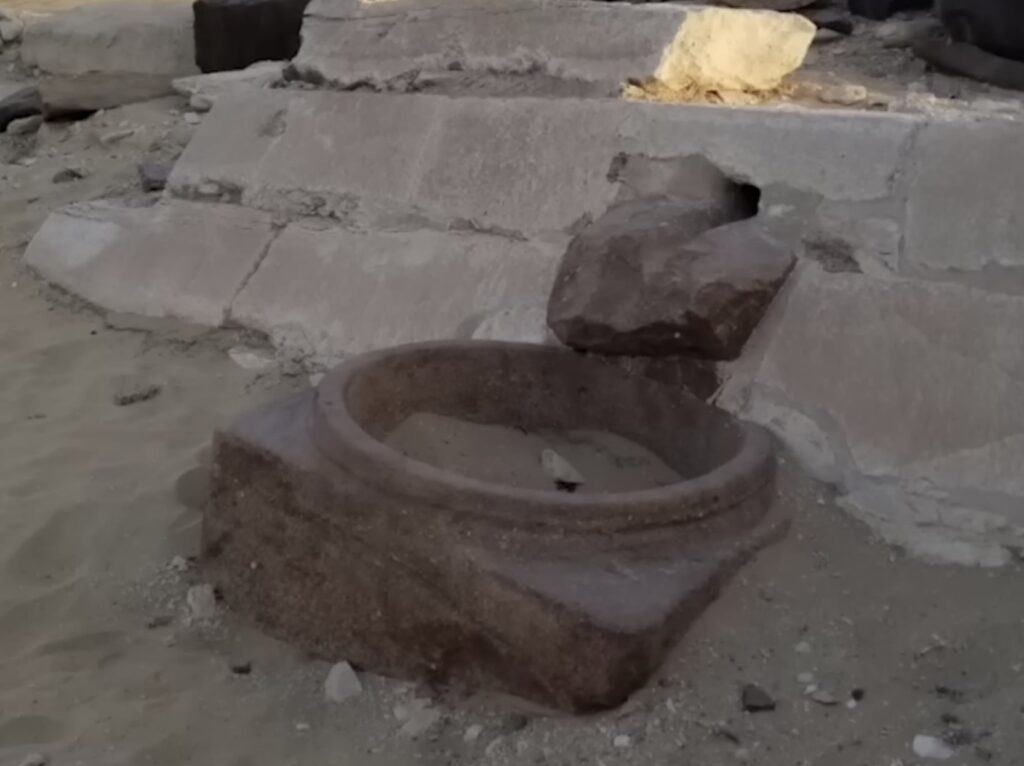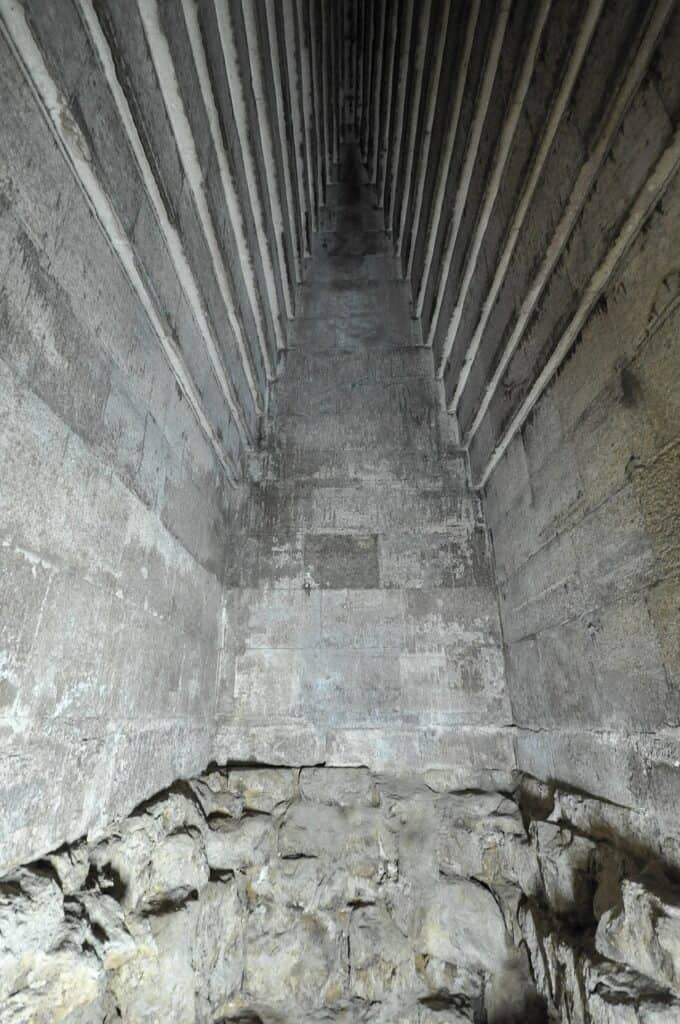Table of Contents
- Dating of the Red Pyramid
- Location of the Red Pyramid
- Theory of The Land Of Chem
- The fertilizer factory
- The Haber Process
- Proof for a fertilizer factory
- The step pyramids: Biogas Digester
- Chamber I: Smell of Ammonia
- Collection bowl made of red quartzite
- Logistics
- Boat Pits
- Bio Gas Digester
- Where can we find the earliest traces of fertilizer?
- References in the Bible

Dating of the Red Pyramid
Current belief: Constructed c. 2510 BC (4th dynasty)
The pyramid’s construction date is unknown because Menkaure’s reign has not been accurately defined, but it was probably completed in the 26th century BC.
New theory: Based on the memories of Khem by Mathias de Stefano, there was only one pyramid at 10,000 BC. It had a crystal at the top and a hall of mirrors. And the use was to experience all perspectives of ourselves. This pyramid was high in vibration.
The Red Piramyid has square columns, indicating that it might date back to Kem Tepi (Atlantean survivors) some 12,000 years ago. The pyramid might have been constructed somewhere around 10,000 and 6,000 BCE.
Mathias de Stefano
The river Nile used to be more wide, more open, bigger and much more water. There was more ice in the mountains, the dessert was smaller, savanna would reach untill the north of Egypt. Elephants would live there. All temples where lost, because they were covered by the time, the geography and the change of weather.
When the age of Leo ended about 12,000 years and the era of Cancer began, and the era of Cancer bought the big flood that covered many regions in the planet with big rains and also the end of the glaciation. All the civilization went away from the seas and went to live to the rivers.
In this period of time, the wars between the different families in the regions of Khem ended with a process of enlightenment, and it divided the country in many regions. This division brought a lot of conflicts in between the people and it was the end of the process of consiousness during the period of the Atlantean colonies. Living there was very easy because everything was ruled by women.
Everything was ruled by circles, and the civilization was treated like sons and daughters until Gemini time came, like around 6,000 BC. This period of time in history made a division in between North and South regions of the consciousness and they were against each other. So they were making what would become Egypt in the next period. The loss of conciousness and the polytheism that started to create a new idea of the temples of the holy places in the River Nile. As the desert started to grow and the only food – the only things that they would have was just in the river they would start to fight for the power of who controls the river. That brought the idea of a pyramidal structure. So they created the military, and they started to create the idea of a new country.
In the era of Taurs, 5,000 years ago where Egypt began. They tried to emulate what Antlanteans did 12,000 years ago. They rebuilt the temples with new architecture. In Atlantean times, they didn’t have round-shape columns. They didn’t have the structure of an Egyptian or a Roman or Greek structure. Their temples were square with square columns. And that’s the main difference between ancient Egypt and Antlantean Egypt. When they started to build the new temples, they used the structure of Mediterranean cultures.
So that’s why you can find these big temples that were 3,000 years ago in Egypt that were financed by Greeks and Roman people. Those temples tried to emulate what the Initiatic Path was and to understand how it worked.
Location of the Red Pyramid
The Red Pyramid, also known as the North Pyramid or Pyramid of Menkaure, is one of the pyramids located at the Dahshur necropolis in Cairo, Egypt.

Named for the rusty reddish hue of its red limestone stones, it is also the third largest Egyptian pyramid, after those of Khufu and Khafre at Giza.
Theory of The Land Of Chem
Reconstruction of the theory of @thelandofchem
The fertilizer factory
The Great Pyramid of Menkaure was a chemical factory to produce fertilizer
Step 1: The step pyramids manufacture Methane Gas (CH4)
Step 2: Ammonia is formed in 3 steps, based on the Haber Proces.
The Haber Process
- Hydrogen Production (Chamber I): Hydrogen gas is usually obtained from natural gas (methane, CH4) through a process called steam methane reforming (SMR). In this process, methane reacts with steam (H2O) at high temperatures to produce hydrogen gas and carbon dioxide.CH4(g) + H2O(g) → CO(g) + 3H2(g)
The carbon monoxide (CO) can react further with steam to produce additional hydrogen gas in a process called the water-gas shift reaction:CO(g) + H2O(g) → CO2(g) + H2(g) - Nitrogen Extraction: Nitrogen gas is obtained from the air. Air is about 78% nitrogen, so nitrogen can be extracted from the atmosphere using a method like fractional distillation, where air is cooled and compressed to separate its components.
- Ammonia Synthesis: In the actual Haber Process, nitrogen gas and hydrogen gas are then reacted together under high pressure (around 200 atmospheres) and high temperature (about 450-550 degrees Celsius) in the presence of an iron catalyst to produce ammonia:N2(g) + 3H2(g) ⇌ 2NH3(g)This reaction is reversible, meaning it can go in both directions. The forward reaction forms ammonia, while the reverse reaction breaks down ammonia into nitrogen and hydrogen. By carefully controlling the conditions (pressure, temperature, and concentration), the yield of ammonia can be maximized.
- Ammonia Recovery and Processing: After the reaction, the mixture is cooled to liquefy the ammonia, which is then separated and collected. Unreacted nitrogen and hydrogen gases are recycled back into the process to maximize efficiency. The obtained ammonia can be used directly as a fertilizer or further processed to produce other nitrogen-based compounds.

Proof for a fertilizer factory
The step pyramids: Biogas Digester


Chamber I: Smell of Ammonia
Chemical Processes: Ammonia is a vital component in several chemical processes, including the production of fertilizers, plastics, and pharmaceuticals.
Waste Treatment: Industrial wastewater treatment plants sometimes use ammonia-based chemicals to neutralize acidic wastewater.
Decomposition: If there are organic materials in the factory room (such as food, plants, or other organic waste), and these materials start decomposing, they can release ammonia as a byproduct, leading to the smell.
The very strong ammonia smell and the very particular layout of the “burial chamber” are telling us that the Red Pyramid was designed to manufacture sodium carbonate (the purest mineral form of natron) and sodium bicarbonate, using a Solvay-like ammonia-soda process.
Collection bowl made of red quartzite

Quartzite is known for its hardness and durability. On the Mohs scale of mineral hardness, quartzite typically has a hardness rating of 7, making it harder than glass and many other types of stone.
Quartzite is relatively dense, which gives it strength and resistance to wear and tear. Its density varies based on the composition and porosity of the rock.
Resistance to Heat: Quartzite is heat-resistant, making it suitable for applications such as fireplace surrounds and hearths.
Resistance to Chemicals: Quartzite is generally resistant to most chemicals, making it a suitable choice for countertops and other surfaces in kitchens and bathrooms.
Non-Porous: High-quality quartzite is non-porous or has very low porosity, which means it is resistant to water absorption. This property makes it suitable for areas where moisture resistance is important.
Logistics
Boat Pits
Several long and narrow pits were found south and east of the king’s pyramid, north of the causeway and between the queens’ pyramids as well. Some pits were found to contain the dismantled remains of the boats which were presumably used in the king’s last journey, his burial. One boat, buried in one of the southern pits, has been rebuilt and can now be seen in the Boat Museum, next to the king’s pyramid. The reassembled boat, made of cedar wood that was imported from the Lebanon, measures 43.3m in length. Its prow and stern were shaped like papyrus stalks.
Bio Gas Digester




Demolisation of the Red Pyramid
In AD 1196, Al-Aziz Uthman, Saladin’s son and the Sultan of Egypt, attempted to demolish the pyramids, starting with that of Menkaure. Workmen recruited to demolish the pyramid stayed at their job for eight months, but found it almost as expensive to destroy as to build. They could only remove one or two stones each day. Some used wedges and levers to move the stones, while others used ropes to pull them down. When a stone fell, it would bury itself in the sand, requiring extraordinary efforts to free it. Wedges were used to split the stones into several pieces, and a cart was used to carry it to the foot of the escarpment, where it was left. Despite their efforts, workmen were only able to damage the pyramid to the extent of leaving a large vertical gash at its northern face.
Where can we find the earliest traces of fertilizer?
- Mesopotamia: One of the cradles of civilization, the Mesopotamian farmers around 10,000 years ago used animal manure to fertilize their crops. The rich soil of the Tigris-Euphrates river valley was a result of natural fertilization, and ancient farmers likely observed the benefits of this natural process and started using manure intentionally.
- Ancient Egypt: The ancient Egyptians, around 5,000 years ago, practiced advanced agricultural techniques along the Nile River. They used a combination of silt deposits from the annual flooding of the Nile and natural composting to enrich their soil. The use of organic materials, including animal and plant residues, contributed to the fertility of their agricultural lands.
- Indus Valley Civilization: In the ancient Indus Valley Civilization, which thrived around 4,500 years ago (in what is now modern-day India and Pakistan), evidence suggests the use of composted organic matter as a fertilizer. Archaeological findings indicate a sophisticated system of agricultural practices, including the use of organic materials for soil enrichment.
- Ancient China: As mentioned earlier, ancient Chinese agricultural practices, dating back over 2,000 years, involved the use of composted materials to improve soil fertility. The Chinese farmers recognized the value of organic waste in enhancing agricultural productivity.
- Roman Empire: The Romans, around 2,000 years ago, used various forms of organic materials, including manure, to fertilize their crops. Roman agricultural writers such as Columella documented the importance of proper fertilization in their farming practices.
References in the Bible
At that time, saith the LORD, they shall bring out the bones of the kings of Judah, and the bones of his princes, and the bones of the priests, and the bones of the prophets, and the bones of the inhabitants of Jerusalem, out of their graves: And they shall spread them before the sun, and the moon, and all the host of heaven, whom they have loved, and whom they have served, and after whom they have walked, and whom they have sought, and whom they have worshipped: they shall not be gathered, nor be buried; they shall be for dung upon the face of the earth.
Jeremiah 8:1-2
The valley gate repaired Hanun, and the inhabitants of Zanoah; they built it, and set up the doors thereof, the locks thereof, and the bars thereof, and a thousand cubits on the wall unto the dung gate.
Neh 3:13
Sources:
https://www.milleetunetasses.com/blog/the-pyramids-of-the-cold/section-14-the-red-pyramid.html
https://isida-project.ucoz.com/


